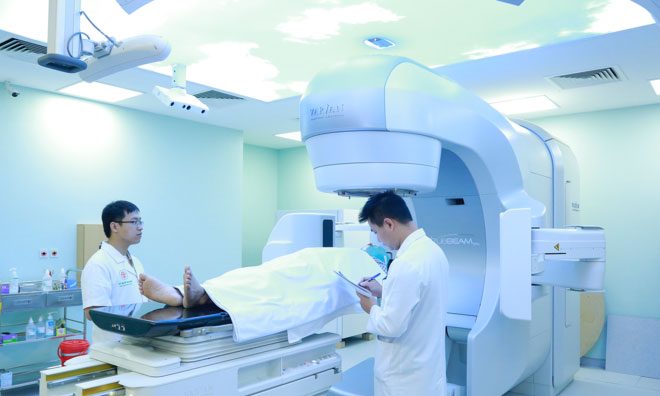Current cancer treatments
Surgery, radiation, chemicals, immunity . are the main cancer treatments today.
Cancer is tending to grow fast in the world, Vietnam is in the group of many patients. It is estimated that Vietnam has 300,000 cancer patients each year, nearly 165,000 new cases and 115,000 deaths.
Doctor Than Van Thinh, Hanoi Cancer Hospital, said cancer treatment is multidisciplinary treatment. Depending on the type of cancer, the disease and the stage of the disease, one or more treatments can be used.
Current major cancer treatments:
Surgery
Surgery is one of the most important treatments for most cancers.
There are two types of palliative surgery (palliative) and radical surgery. Radical surgery is selected at an early stage, tumor removal and lymphadenopathy. Palliative surgery is the plan when the patient is in a late stage, the cancer has spread. At that time, the patients no longer have the ability to radical surgery but the main purpose is to reduce stress and avoid ulcerative infection.
Surgery may be combined with other treatments such as radiotherapy, chemotherapy, endocrinology, immunity .
Surgery may cause life-threatening complications or loss of physiological functions of some organs. Therefore, the doctor considers the extent of the surgery to avoid damage to vital organs. Malignant lesions have passed the focal stage, the role of surgery is no longer appropriate.
Treatment of radiation
This is the second treatment commonly chosen after surgery, using ionizing radiation to treat cancer.

The patient is undergoing radiotherapy on modern systems.(Photo: AN).
There are two types of radiation therapy: external radiation and radiation.
- External radiation is a source of radiation outside the body including radiation therapy machines such as cobalt, accelerator . The doctor must perform patient simulations before radiation therapy. Then, the doctor used a special X-ray machine that features radiotherapy with a radioactive source with an X-ray lamp head to determine the area to be irradiated (projection field) on the patient. Accurate radiotherapy will increase the effectiveness of treatment, contributing to curing more than 50% of newly diagnosed cancers.
- Close-up radiation is a radioactive source placed in the patient's body. However, adjuvant radiotherapy is rarely used except for some very early cancers, usually in combination with external radiation and other treatments.
Chemical treatment
When cancer spreads, local and regional therapies such as surgery and radiation are often ineffective. At that time, using cancer drugs, especially chemicals, can prevent the progression of the disease.
Anti-cancer chemicals are all cytotoxic substances. Therefore, indications for chemotherapy are based on many factors such as stage of disease, type of disease, age of the patient, previously treated methods, patient's condition to determine specific indications. of chemotherapy.
"Must always consider one side of the benefits of chemotherapy, one side of toxicity and possible dangers , " Thinh said.
Other methods

Technicians who apply stem cells replicate the blood-forming system for patients.(Photo: T. Hang).
Endocrine treatment plays an important and indispensable role in multimodal treatment such as positive endocrine receptor breast cancer, endometrial cancer, thyroid cancer .
Targeted cancer treatment is the use of drugs to prevent the growth and spread of cancer cells by blocking specific molecules involved in the process of oncogenesis and tumor development. This is a more effective treatment than current treatments and less cytotoxic.
Immunotherapy has two forms: nonspecific passive immunity and non-specific active immunity . When combined with traditional treatments, immunity will increase the ability to destroy cancer cells, helping patients respond to better treatment. This method is indicated for many common cancers today such as melanoma, lung, stomach, liver, bile, pancreas, esophagus, colon, cervix, breast ovary, brain tumor and tumors. special neck area .
- Scientists have found a way to kill cancer in seconds
- Enteric bacteria can affect the body's response to cancer treatments
- Cure cancer with light
- Dangerous cancer - cause and prevention
- How is cancer treated?
- Testicular cancer: Causes, symptoms and treatment
- Can categorize prostate cancer
- Real damage effects of sperm cancer
- Hope for the treatment of kidney cancer
- Can wild berries prevent cancer?
- Similarities between breast and ovarian cancer
- X-ray interference, a turning point in cancer treatment
 Why is Australia the country with the highest cancer rate in the world while Vietnam ranks 100th?
Why is Australia the country with the highest cancer rate in the world while Vietnam ranks 100th? New drug causes cancer to 'starve'
New drug causes cancer to 'starve' Common cancers in men
Common cancers in men America's incredible discovery: The most feared cancer cell is love
America's incredible discovery: The most feared cancer cell is love